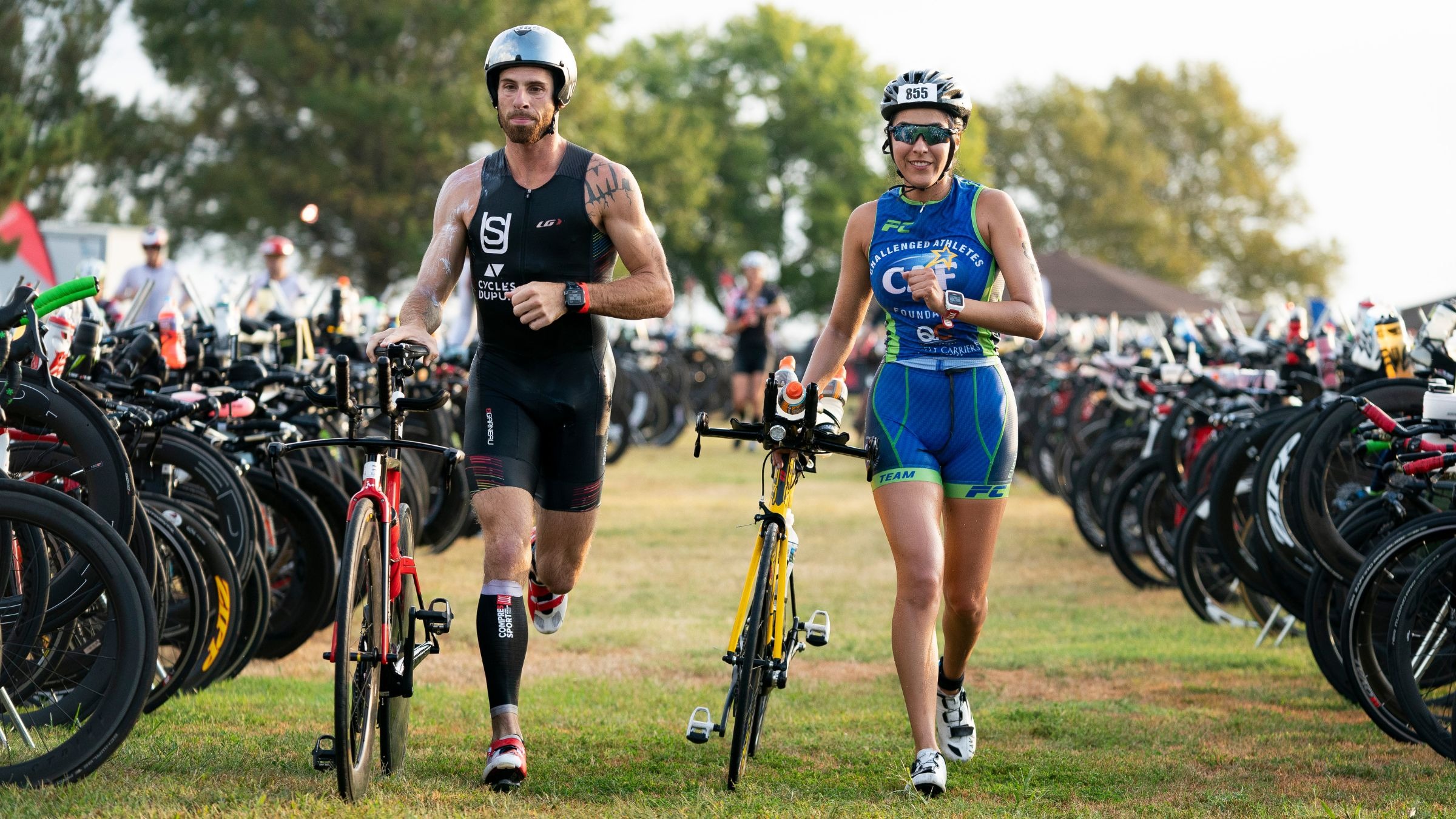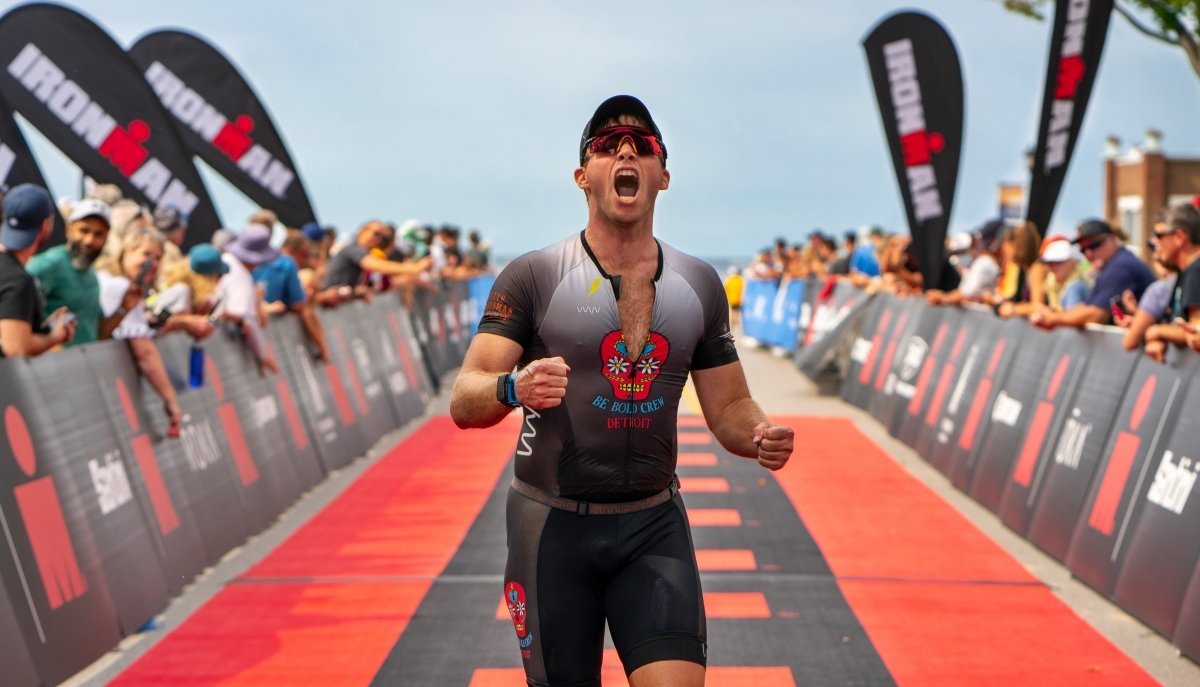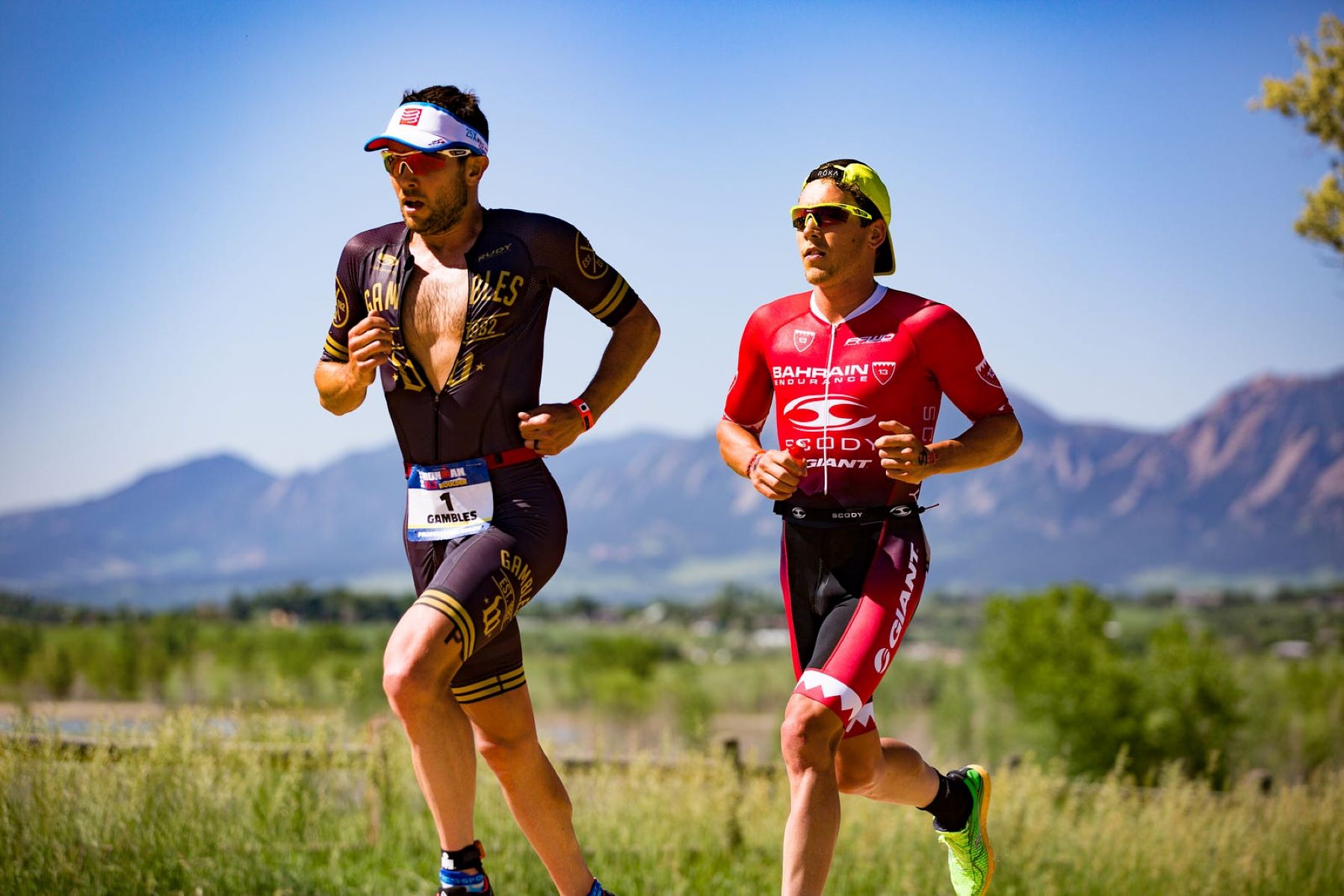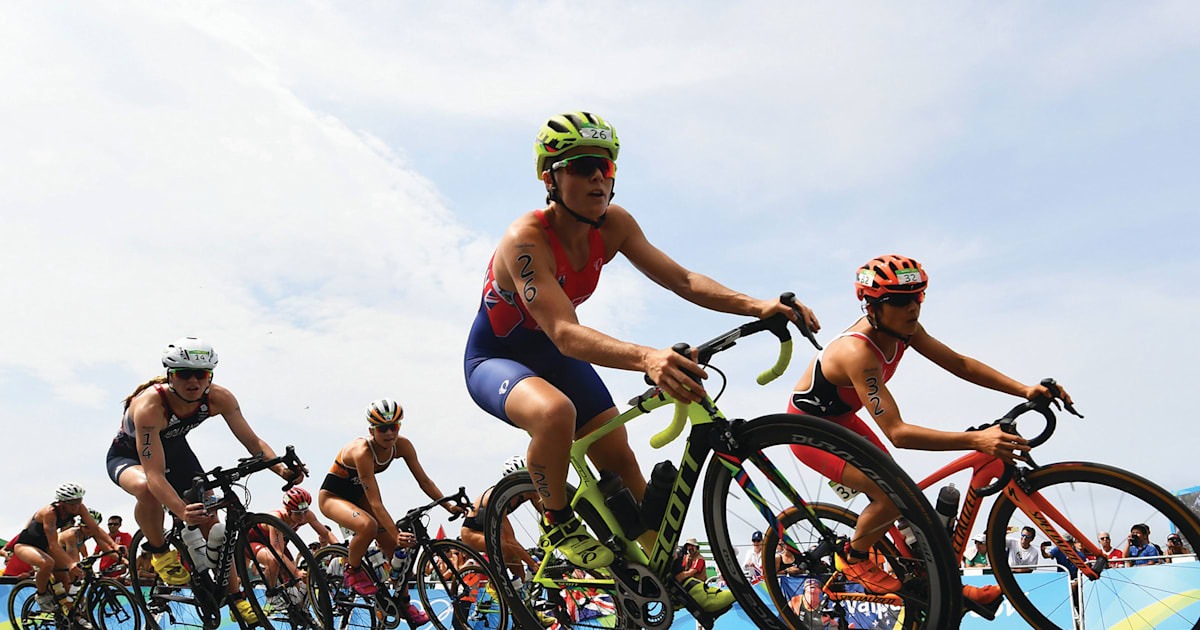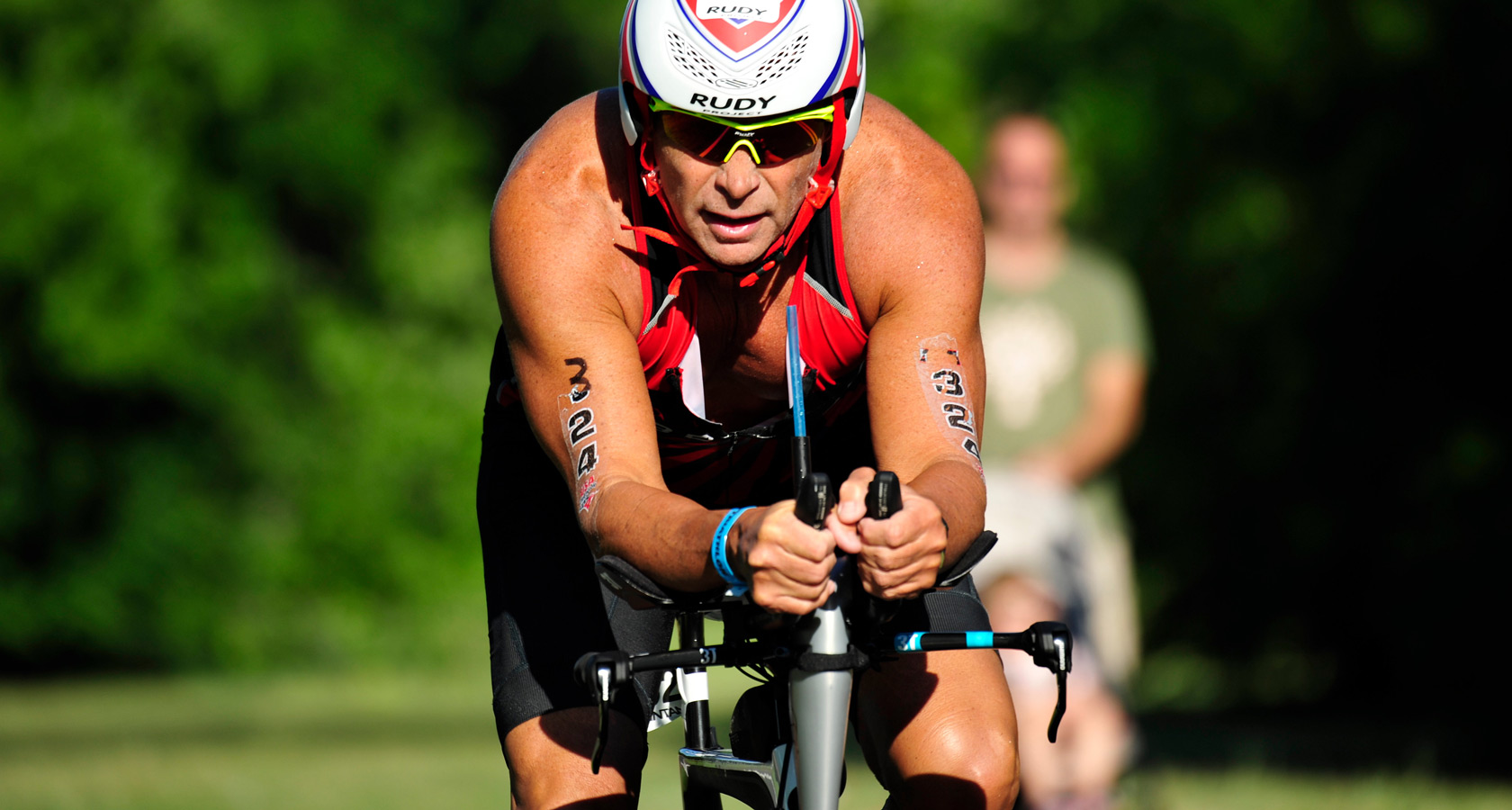

Featured
How To Train For Triathlon
Modified: January 22, 2024
Discover the ultimate training guide on how to train for a triathlon, featuring expert tips and strategies to enhance your performance and conquer the challenges of multisport racing.
Introduction
Training for a triathlon is no small feat. It requires a combination of endurance, strength, and mental fortitude. Whether you are a seasoned athlete looking to challenge yourself or a beginner venturing into the world of triathlons, proper training is essential to optimize your performance and minimize the risk of injury.
A triathlon consists of three disciplines: swimming, cycling, and running. Each discipline presents its own unique challenges and requires specific training techniques and skills. Additionally, triathlons come in various distances, from sprint to Olympic to Ironman. Regardless of the distance you choose, a comprehensive training plan is crucial in preparing your body and mind for the demands of the race.
Setting clear goals is the first step in your triathlon training journey. Whether your goal is to complete your first triathlon, improve your personal best, or qualify for a specific race, identifying your objectives will help guide your training and keep you motivated along the way.
Once you’ve established your goals, it’s time to develop a training plan. This involves mapping out your workouts, determining the frequency and duration of each session, and incorporating different types of training such as endurance, speed work, and strength training. Consulting with a coach or experienced triathlete can be valuable in creating a well-rounded plan tailored to your abilities and goals.
The first discipline of a triathlon is swimming, and mastering proper technique is crucial to conserving energy and maintaining a steady pace. Incorporating swimming drills into your training can help improve your stroke efficiency and overall swim performance.
Cycling is the second discipline, and having a solid foundation in cycling techniques is essential to navigate different terrains and handle the diverse challenges that may arise during a triathlon. Whether you’re training on the road or utilizing indoor cycling equipment, incorporating interval training and hill repeats can improve your cycling speed and endurance.
The final discipline is running, which often proves to be the most mentally and physically demanding part of a triathlon. Enhancing your running technique and incorporating interval training and tempo runs can improve your running efficiency and help you maintain a steady pace throughout the race.
While swimming, cycling, and running are the core components of triathlon training, incorporating strength training exercises is essential to prevent injuries and improve overall performance. Focusing on core stability, leg strength, and upper body strength can enhance your overall power and stability during the race.
Proper nutrition and hydration play a vital role in supporting your training and race day performance. Consuming a balanced diet and staying properly hydrated will help fuel your workouts and aid in recovery. It’s important to experiment with different fueling strategies during training to find what works best for your body.
Injury prevention and recovery strategies are also important aspects of triathlon training. Incorporating rest days and active recovery sessions, as well as implementing proper warm-up and cool-down routines, can help reduce the risk of injuries and speed up recovery.
Mental preparation is often underestimated but is equally important in triathlon training. Developing mental fortitude, focusing on positive self-talk, and utilizing visualization techniques can help you push through challenging moments and stay motivated during the race.
In this comprehensive guide, we will delve into each aspect of triathlon training, providing you with valuable insights, techniques, and tips to help you train effectively and conquer your triathlon goals. So, fasten your seatbelt, put on your running shoes, and let’s embark on this exciting journey together!
Setting Goals
Setting clear and achievable goals is the foundation of a successful triathlon training plan. Whether you are a seasoned triathlete or a beginner, establishing your objectives will guide you throughout your training and keep you motivated. Goals can vary from completing your first triathlon to improving your personal best or qualifying for a specific event.
When setting your goals, it’s important to make them specific, measurable, attainable, relevant, and time-bound (SMART). Instead of saying, “I want to do a triathlon,” a more specific goal would be, “I want to complete a sprint-distance triathlon in under 2 hours by the end of the year.
Having specific goals provides clarity and allows you to break them down into smaller, manageable steps. Measurable goals allow you to track your progress and adjust your training as needed. For example, you can set targets for swim, bike, and run distances or aim for specific time improvements in each discipline.
Ensure that your goals are attainable and realistic based on your current fitness level and available training time. It’s important to challenge yourself, but setting unattainable goals can lead to frustration and burnout. Gradually increase the difficulty of your goals as you progress and gain more experience.
Align your goals with your personal priorities and motivations. Ask yourself why you want to achieve these goals and how they align with your values. This will give you a sense of purpose and keep you committed during challenging training sessions.
Lastly, set a timeframe for your goals. Having a deadline creates a sense of urgency and helps you structure your training plan. However, be realistic about the time needed to achieve your goals and allow for setbacks and adjustments along the way.
Remember that goals are not set in stone and can be modified as necessary. Life happens, and circumstances may change. Be flexible and willing to adapt your goals based on your progress, priorities, and any unexpected events that may arise.
In summary, setting SMART goals that are specific, measurable, attainable, relevant, and time-bound is essential in triathlon training. Having clear objectives will guide your training, keep you motivated, and ultimately lead you to success on race day. So take some time to reflect on what you want to achieve and commit to your goals. It’s time to turn your dreams into reality!
Developing a Training Plan
A well-structured training plan is essential for triathlon preparation. It ensures that you are maximizing your training time, targeting specific areas of improvement, and gradually building your fitness and endurance. Here are some key steps to consider when developing your triathlon training plan:
1. Assess Your Current Fitness Level: Before diving into training, take the time to evaluate your current fitness level in each discipline. This will help you gauge where you are starting from and create a baseline for future progress. You can do this by timing yourself in swim, bike, and run distances and assessing your overall stamina.
2. Set a Training Schedule: Determine how many days per week you can commit to training and create a schedule that works for you. It’s important to strike a balance between training and recovery to prevent burnout and injury. Aim for at least 2-3 sessions per discipline per week, with rest days and active recovery days in between.
3. Incorporate Different Types of Training: To improve your overall performance, incorporate a variety of training techniques into your plan. This includes endurance workouts to build stamina, speed work to increase your pace, and strength training to enhance your power and stability. Mix up your sessions to keep them interesting and challenging.
4. Gradually Increase Training Volume: It’s important to progress gradually to avoid overtraining and injury. Start with lower training volumes and gradually increase the duration and intensity of your workouts. This progressive approach allows your body to adapt and helps build a solid foundation for future training.
5. Allow for Recovery: Recovery is just as important as training. Schedule rest days throughout the week to give your body time to repair and rebuild. Additionally, incorporate active recovery activities such as yoga, stretching, and foam rolling to enhance circulation and reduce muscle soreness.
6. Listen to Your Body: Pay attention to any signs of fatigue, pain, or overtraining. If you’re feeling excessively tired or experiencing any discomfort, it’s important to rest and recover. Pushing through pain can lead to injury and setbacks. It’s better to have a few days of rest than weeks or months of forced time off due to injury.
7. Seek Guidance if Needed: If you’re new to triathlon training or unsure about your plan, consider seeking guidance from a coach or experienced triathlete. They can provide expert advice, create a personalized plan based on your goals and abilities, and offer feedback and support throughout your journey.
Remember, developing a training plan is not a one-size-fits-all approach. Customize your plan to fit your schedule, abilities, and goals. Be flexible and willing to make adjustments as needed. Ultimately, the goal is to create a plan that challenges and pushes you while still providing enough time for rest and recovery. So, get organized, commit to your training schedule, and get ready to crush your triathlon goals!
Swimming Techniques and Drills
Swimming is often considered the most challenging discipline for many triathletes. Improving your swimming technique can not only enhance your efficiency and speed in the water but also conserve energy for the rest of the race. Here are some essential swimming techniques and drills to incorporate into your training:
1. Body Position: Maintaining a streamlined body position is key to reducing drag in the water. Practice keeping your body horizontal with your head in line with your spine. Engage your core and avoid sinking your hips or lifting your legs too high.
2. Breathing Technique: Proper breathing technique is crucial for efficient swimming. Breathe bilaterally (alternating sides) to maintain balance and symmetry. Exhale smoothly and fully underwater and time your inhales with your arm strokes to minimize disruption to your rhythm.
3. Arm Stroke: Focus on a high elbow catch, engaging your lats and pulling your hand through the water in a S-shaped motion. Keep your hand relaxed and fingers slightly apart to maximize water resistance. Finish each stroke by brushing your hip before recovering your arm out of the water.
4. Leg Kick: A strong and efficient leg kick will help propel you through the water. Keep your legs relatively straight with a slight knee bend and generate power from your hips and glutes. Practice a steady and controlled kick to avoid wasting energy.
5. Drills for Technique Improvement: Incorporating swimming drills into your training can help isolate and improve specific aspects of your technique. Some popular drills include kickboard drills, catch-up drills, single-arm drills, and fingertip drag drills. These drills can enhance your body position, arm stroke, and coordination.
6. Open Water Skills: If your triathlon involves an open water swim, it’s essential to practice skills specific to those conditions. Practice sighting to navigate and stay on course, and practice swimming in a group to simulate race conditions and develop the ability to draft off other swimmers.
7. Swim Sets: Include swim sets in your training to build endurance and speed. These sets can consist of intervals, where you swim at a challenging pace for a set distance or time, followed by a short rest interval. Incorporating different stroke lengths and intensities will help improve your overall swimming fitness.
Remember, becoming a proficient swimmer takes time and practice. Be patient with yourself and focus on one aspect of your technique at a time. Consider seeking guidance from a swim coach or joining a masters swimming group to receive feedback on your technique and improve your skills.
By incorporating proper swimming techniques and drills into your training, you’ll be able to swim with ease and efficiency, giving you a solid foundation for the rest of your triathlon. So dive in, embrace the challenges, and watch your swimming abilities soar!
Cycling for Triathlon
Cycling is a significant component of triathlon, and mastering the art of cycling can greatly impact your overall performance. From maintaining a steady pace to conquering challenging terrains, here are some key aspects to consider when it comes to cycling for triathlon:
1. Bike Fit: Ensuring your bike is properly fitted to your body can make a significant difference in your comfort and efficiency. A professional bike fit can adjust your saddle height, handlebar reach, and other components to optimize your riding position. This will reduce the risk of discomfort and injury during long rides.
2. Cadence and Gear Selection: Cadence refers to the rate at which you pedal. Aim for a comfortable cadence between 80-100 revolutions per minute (RPM). This will help you maintain a steady pace and reduce stress on your muscles. Practice shifting gears to find the optimal gear for different terrains and inclines.
3. Hills and Descents: Triathlon courses often include hills, so it’s essential to train for both climbing and descending. When climbing, shift into an easier gear, maintain a consistent cadence, and focus on efficient pedaling technique. When descending, maintain a low, stable position, and use your brakes judiciously to maintain control.
4. Drafting: In non-drafting triathlons, maintaining a legal drafting distance is important. Practice riding in a group or with a training partner to develop the skills needed to navigate in close proximity to others. Learn to read the movements and signals of riders ahead of you to anticipate their actions.
5. Interval Training: Including interval training in your cycling workouts can improve your speed and endurance. Alternating between periods of high-intensity efforts and recovery can help develop your cardiovascular fitness and train your body to handle intensities similar to race conditions.
6. Long Rides: Increasing your cycling endurance is crucial for longer triathlon distances. Gradually build up the duration of your long rides to mimic the demands of the race. Practice pacing yourself, fueling appropriately, and staying mentally focused during extended periods in the saddle.
7. Bike Handling and Safety: Developing good bike handling skills is vital for safety during races and training. Practice maneuvering around obstacles, maintaining a straight line, and using hand signals to communicate with other road users. Always wear a helmet, follow traffic rules, and stay aware of your surroundings.
8. Bike Maintenance: Regular bike maintenance ensures optimal performance and reduces the risk of mechanical issues during races. Keep your bike clean, check tire pressure before each ride, and regularly inspect the brakes, gears, and chain for wear and tear. Consider having a professional bike mechanic perform regular tune-ups.
Remember that consistent practice and training are key to improving your cycling skills. Don’t be afraid to challenge yourself and push beyond your comfort zone. With dedication and perseverance, you’ll enhance your cycling abilities and be well-prepared to conquer the bike leg of your triathlon.
Running Techniques and Drills
Running is the final leg of a triathlon and often the most mentally and physically demanding. Improving your running technique can help you maintain a steady pace, conserve energy, and finish strong. Here are some essential running techniques and drills to incorporate into your training:
1. Posture and Form: Maintain an upright posture with a slight forward lean. Avoid excessive leaning backward or bending forward at the waist. Keep your shoulders relaxed and your arms swinging in a controlled motion, striving for symmetry. Maintain a quick cadence and engage your core for stability.
2. Foot Strike: Aim for a midfoot or forefoot strike rather than landing on your heel. This allows for a more efficient transfer of energy and reduces the risk of injuries. Focus on running lightly and quietly, minimizing ground contact time.
3. Cadence and Stride Length: Strive for a cadence of around 180 steps per minute (SPM) to increase your running efficiency. Short, quick strides help reduce the impact on your joints and muscles. Increase your cadence by practicing drills such as fast feet or running to a metronome.
4. Hills and Downhill Running: Incorporate hill repeats into your training to build strength and improve your running technique. When running uphill, lean slightly forward and shorten your stride. On downhill sections, control your speed by leaning slightly back and maintaining a quick cadence.
5. Interval Training: Including interval training in your running workouts can help improve your speed and endurance. Alternating between high-intensity efforts and recovery periods challenges your cardiovascular system and improves your ability to sustain a faster pace.
6. Tempo Runs: Tempo runs are sustained efforts at a comfortably hard pace, just below your maximum effort. Incorporate this type of run into your training to improve your lactate threshold and race pace. Start with shorter distances and gradually increase the duration of your tempo runs.
7. Running Drills: Drills can help improve your running technique and reinforce proper movement patterns. Incorporate drills such as high knees, skip drills, butt kicks, and strides into your warm-up routine to enhance your running form and activate key muscle groups.
8. Recovery Runs and Rest Days: Don’t underestimate the importance of recovery in your training plan. Incorporate easy paced recovery runs and rest days to allow your body to recuperate and adapt to the training stress. Listen to your body and take rest days when needed to prevent overtraining and reduce the risk of injury.
Remember to gradually increase your running volume and intensity to avoid overtraining and injury. Take the time to warm up properly before each run, allowing your muscles and joints to loosen up. Additionally, invest in a good pair of running shoes that provide proper support and cushioning for your foot type and running style.
By focusing on proper running technique, incorporating drills, and gradually building your endurance and speed, you’ll be well-prepared to tackle the run leg of your triathlon. Embrace the challenge, stay consistent, and watch your running capabilities soar!
Strength Training for Triathlon
Strength training plays a significant role in enhancing triathlon performance and minimizing the risk of injuries. Building overall strength and targeting specific muscle groups can improve your power, endurance, and stability. Here are some key aspects to consider when incorporating strength training into your triathlon training program:
1. Full-Body Strength: Aim for a well-rounded strength training program that targets all major muscle groups. This includes exercises for your core, legs, arms, and back. A strong and stable core helps maintain proper posture and form during swimming, cycling, and running.
2. Functional Exercises: Focus on exercises that mimic triathlon movements and improve your overall functional fitness. Incorporate movements such as squats, lunges, step-ups, and push-ups to develop strength in specific muscle groups used in each discipline of triathlon.
3. Plyometric Training: Plyometric exercises involve explosive movements that can improve your power and speed. Incorporate exercises such as box jumps, squat jumps, and medicine ball throws to enhance your muscular power and improve your running and cycling performance.
4. Balance and Stability Training: Triathlons demand a high level of balance and stability. Incorporate exercises such as single-leg squats, stability ball exercises, and single-leg balance exercises to improve your coordination and enhance your ability to stay balanced on the bike and during the run.
5. Periodization: Use periodization principles when designing your strength training program. Periodization involves breaking your training into specific phases, targeting different aspects of strength and endurance throughout the training cycle. This helps prevent plateauing and allows for progressive overload.
6. Cross-Training: Consider incorporating cross-training activities such as yoga, Pilates, and swimming into your routine. These activities can improve flexibility, mobility, and muscle balance, ultimately enhancing your overall performance and reducing the risk of overuse injuries.
7. Rest and Recovery: Allow ample time for rest and recovery between strength training sessions. Your muscles need time to repair and rebuild to become stronger. Aim for at least one or two days of rest between strength training sessions and listen to your body if it needs additional rest.
8. Professional Guidance: If you are new to strength training or unsure about proper technique, consider seeking guidance from a certified strength and conditioning specialist. They can create a personalized program, teach you correct form, and help you progress safely and effectively.
Remember that strength training should complement your triathlon training and not overshadow it. Aim for 2-3 strength training sessions per week, allowing ample time for recovery and adaptation. Adjust the frequency, intensity, and volume of your strength training program based on your individual needs and race goals.
By incorporating a well-structured strength training program into your triathlon training, you’ll develop the foundational strength, stability, and power needed to excel in each discipline. So grab those weights, hit the gym, and get ready to take your triathlon performance to the next level!
Nutrition and Hydration
Nutrition and hydration play a critical role in supporting your triathlon training and optimizing your performance on race day. Proper fueling and hydration strategies can help you sustain energy levels, improve recovery, and prevent gastrointestinal issues during the demanding triathlon. Here are some key considerations to keep in mind:
1. Balanced Diet: Focus on consuming a well-balanced diet that includes carbohydrates, proteins, and healthy fats. Carbohydrates provide the primary fuel source during exercise, so prioritize complex carbohydrates such as whole grains, fruits, and vegetables. Proteins aid in muscle repair and recovery, and healthy fats provide sustained energy.
2. Pre-Training and Pre-Race Meals: Consume a balanced meal 2-3 hours before training sessions or races to ensure proper energy availability. Include easily digestible carbohydrates, lean proteins, and a small amount of healthy fats. Avoid trying new or unfamiliar foods before important training sessions or races.
3. Fueling During Training and Races: For longer training sessions and races, it’s crucial to replenish your energy stores. Incorporate easily digestible carbohydrates, such as energy gels, sports drinks, and energy bars, to maintain blood sugar levels and prevent energy depletion. Experiment during training to find what fuels work best for you.
4. Hydration: Staying properly hydrated is essential for optimal performance and recovery. Drink water regularly throughout the day and during training sessions. During longer training sessions and races, include electrolyte-rich sports drinks to replenish lost minerals. Monitor your urine color to ensure you are adequately hydrated.
5. Electrolyte Balance: Electrolytes, such as sodium, potassium, and magnesium, play a vital role in muscle function and hydration levels. Include foods rich in electrolytes, such as bananas, oranges, yogurt, and nuts, in your daily diet. Additionally, consider using electrolyte supplements during intense training sessions or races.
6. Recovery Nutrition: Proper post-workout nutrition is crucial for muscle recovery and glycogen replenishment. Consume a combination of carbohydrates and proteins within 30-60 minutes after training sessions or races. This could include a recovery drink, a smoothie with protein powder, or a balanced meal with lean protein and complex carbohydrates.
7. Listen to Your Body: Every athlete is unique, so it’s important to listen to your body’s signals and adjust your nutrition and hydration accordingly. Pay attention to hunger and thirst cues, and experiment with different fueling strategies during training to determine what works best for you.
8. Practice: It’s essential to practice your nutrition and hydration strategies during training to fine-tune your approach. Use long training sessions as an opportunity to test different foods, drinks, and timing. This will ensure that you have a well-established plan for race day.
Remember, proper nutrition and hydration are not just limited to race day. Consistency is key, so make good nutritional choices a part of your daily routine. Pay attention to your body’s needs, consult with a sports nutritionist if necessary, and develop a fueling strategy that works best for your individual needs and goals.
By fueling your body properly and staying hydrated, you’ll have the energy and endurance to perform at your best during training and on race day. So fuel up, hydrate well, and get ready to conquer your triathlon goals!
Injury Prevention and Recovery Strategies
In any athletic pursuit, including triathlon, injury prevention and effective recovery strategies are essential for maintaining a consistent training schedule and optimizing performance. Here are some key considerations to help you minimize the risk of injuries and recover effectively:
1. Proper Warm-Up and Cool-Down: Prior to training or racing, incorporate a dynamic warm-up routine that activates the muscles and increases blood flow. This can include exercises such as leg swings, walking lunges, and arm circles. After your workout, cool down with light stretching and static stretches to promote muscle recovery and flexibility.
2. Gradual Progression: Avoid overtraining and reduce the risk of overuse injuries by gradually increasing your training volume and intensity. Increase your mileage, speed, or duration by no more than 10% per week to allow your body to adapt and recover effectively.
3. Strength and Stability Training: Include strength training exercises that target muscles commonly used in triathlon, such as your core, glutes, and stabilizer muscles. Strengthening these areas can help prevent imbalances and improve overall stability, reducing the risk of injury.
4. Listen to Your Body: Pay attention to any signs of pain, discomfort, or fatigue. If you experience persistent or worsening pain, it’s important to not push through it. Take a rest day or consult with a healthcare professional to prevent further injury or damage.
5. Cross-Training: Incorporate cross-training activities into your routine to alleviate the repetitive stress on your body from triathlon training. Activities like swimming, cycling, yoga, or Pilates can help balance the muscles and give your body a break from the constant impact of running.
6. Recovery Techniques: Utilize various recovery techniques to enhance your body’s ability to repair and bounce back from training sessions. This can include stretching, foam rolling, massage therapy, ice baths, and compression garments. Experiment with different methods to discover what works best for you.
7. Adequate Rest and Sleep: Give your body the time it needs to rest and recover. Ensure you are getting enough sleep each night, as quality sleep plays a crucial role in the body’s healing and recovery processes. Aim for 7-9 hours of uninterrupted sleep for optimal recovery.
8. Proper Nutrition: Fueling your body with nutrient-dense foods not only supports your training but also aids in recovery. Include foods rich in antioxidants, vitamins, and minerals to promote tissue repair and reduce inflammation. Maintain a well-balanced diet that supports optimal health and recovery.
Remember, prevention is always better than dealing with an injury. Incorporate these strategies into your training routine from the beginning to prioritize injury prevention. Be proactive in your recovery, addressing any issues as soon as they arise, and giving yourself the necessary time to heal and recover.
By implementing injury prevention strategies and allowing ample time for recovery, you’ll reduce the risk of setbacks and be able to consistently train and perform at your best. So, take care of your body, be mindful of warning signs, and prioritize injury prevention and recovery throughout your triathlon journey.
Mental Preparation and Race Day Strategies
Triathlon is not only a test of physical endurance but also a mental challenge. Building mental resilience and employing effective race day strategies can greatly contribute to your overall performance. Here are some key considerations for mental preparation and race day strategies:
1. Goal Visualization: Visualize yourself crossing the finish line and achieving your race day goals. Create a mental image of overcoming challenges and staying focused throughout the race. The power of visualization can help boost confidence and prepare your mind for success.
2. Positive Self-Talk: Develop a positive and affirming inner dialogue. Replace negative thoughts with encouraging and empowering statements. Practice using positive self-talk during training sessions to build resilience and foster a positive mindset on race day.
3. Race Day Routine: Establish a race day routine that helps you feel prepared and comfortable. This can include a structured warm-up routine, a pre-race meal plan, and specific rituals or habits that promote a sense of familiarity and confidence.
4. Break the Race into Segments: Break down the race into smaller, manageable segments. Focus on one discipline at a time or set smaller goals for each leg of the race. This will help prevent overwhelm and allow you to stay mentally present and focused on each part of the race.
5. Stay Present and Adapt: During the race, stay focused on the present moment rather than getting caught up in future scenarios or past mistakes. Adapt to the changing conditions and adjust your strategies as needed. Embrace the unexpected and remain flexible throughout the race.
6. Harness Nerves as Energy: Nervousness and pre-race jitters are natural. Instead of viewing them as negative, channel that energy into enthusiasm and excitement. Reframe nerves as a sign that you are ready to tackle the challenge ahead.
7. Use Mantras and Affirmations: Create short, powerful mantras or affirmations that resonate with you. Repeat them to yourself during challenging moments in the race to stay motivated and focused. Examples include “I am strong and capable” or “I can overcome any obstacle.”
8. Embrace the Ebb and Flow: Triathlons have their ups and downs. Accept that there will be difficult moments and understand that it is part of the journey. Embrace the ebb and flow of the race, and trust in your training and mental preparation to carry you through.
9. Emotion Regulation: Practice emotional regulation techniques, such as deep breathing or visualization, to manage stress and anxiety during the race. Learn to recognize and address any negative emotions that arise, allowing yourself to refocus and move forward.
10. Reflect and Learn: After the race, take time to reflect on your experience and learn from it. Celebrate your achievements and identify areas for improvement. Use this knowledge to inform and inspire your future training and racing endeavors.
Remember, mental preparation is just as important as physical training for a triathlon. Cultivate a positive mindset, develop effective race day strategies, and embrace the mental challenges that come with the sport. By doing so, you’ll perform at your best and make the most of every triathlon experience.
Conclusion
Congratulations! You have now gained valuable insights into the world of triathlon training. From setting goals to developing a comprehensive training plan, and from improving swimming techniques to honing cycling and running skills, you now possess the knowledge to embark on a successful triathlon journey. Additionally, you have learned the importance of strength training, nutrition, injury prevention, recovery strategies, and mental preparation.
As you embark on your triathlon training, remember that consistency, perseverance, and adaptability are key. Every step you take in your training brings you closer to achieving your goals. Embrace the challenges, be kind to yourself, and enjoy the journey along the way.
Triathlon is not just about crossing the finish line but also about personal growth, pushing your limits, and discovering what you are truly capable of. With proper training, mental preparation, and a positive mindset, you can conquer the challenges that the sport presents.
Remember to always listen to your body, seek guidance from experienced coaches or athletes when needed, and prioritize rest and recovery. Celebrate every milestone, no matter how small, and use any setbacks as learning opportunities to propel yourself forward.
Now, it’s time to dive into the pool, hit the road on your bike, and lace up your running shoes. Train hard, fuel your body properly, and most importantly, enjoy the exhilaration of crossing that finish line on race day.
Whether you’re a beginner or a seasoned athlete, the journey of triathlon is one of self-discovery, resilience, and personal triumph. So, fearlessly take on the challenge, embrace the unknown, and let the transformative power of triathlon guide you towards becoming the best version of yourself.
Good luck on your triathlon journey, and may you accomplish all your goals and realize your dreams as you push your limits both on and off the course! Triathlon awaits – go out there and make waves!
